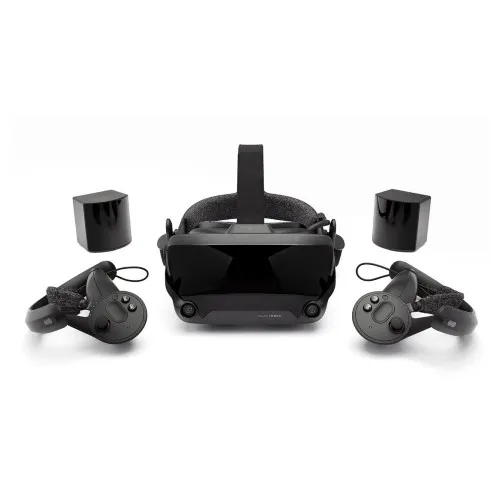Valve Index review: Wrapping your fingers around VR
Summary
The Valve Index pushes into the virtual reality market with all 10 fingers, but is finger tracking enough to make this premium VR headset worth it?
- Crisp and vibrant visuals
- Excellent finger-tracking controllers
- Comfortable and sleek headset
- Substantial set-up pains
- Some external light bleed into headset
- Occasional tracking glitches
The existence of the Valve Index is curious to say the least. Valve – which made its name first as a great game developer, then a middleware engine provider, and is now best known for its PC game marketplace Steam – already has a VR headset brand in the market. Valve and HTC are partners in the Vive, which has numerous iterations – most notably the recently released HTC Vive Pro 2.
The Valve Index would appear to be a direct competitor of the HTC Vive Pro 2, and to a lesser extent the Vive Cosmo and Vive Focus range. The question must surely become then, can it stand out on its own as a worthwhile alternative? Or is it already superseded by its more recently released sibling?
I've previously reviewed the HTC Vive Pro 2, which released in mid-2021. The Valve Index released a full 2 years earlier in mid-2019. However, its global availability had a slow rollout, making it feel in many ways like new tech to Australians. In this review, I've put the Valve Index through the same tests I put the HTC Vive Pro 2, the PSVR headset, and all the units I've covered.
Valve Index vs HTC Vive Pro 2 specs
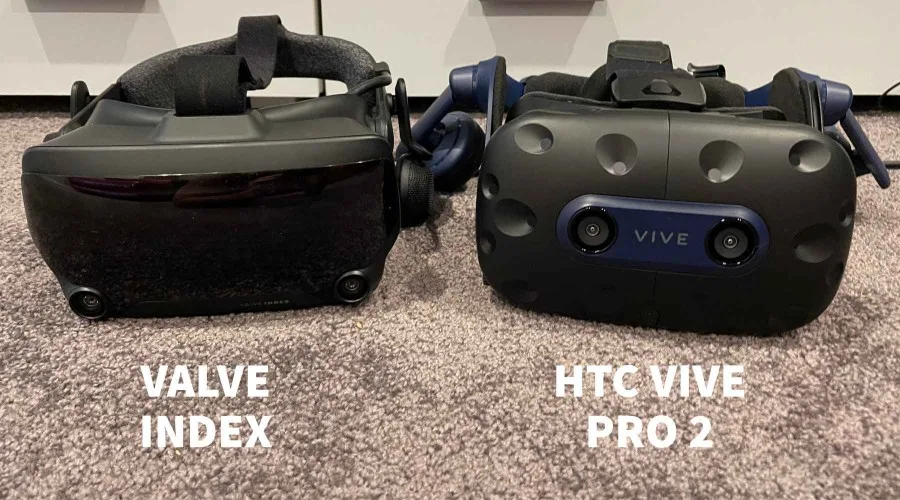
Image: Chris Stead/Finder
There are numerous headsets available to gamers who want to level-up to the VR experience, but the best apples-with-apples comparison for the Valve Index is the HTC Vive Pro 2. Both headsets are at the premium end of the spectrum. Both aim to be the best of the best.
With an additional 2 years of development for the HTC Vive Pro 2, it should come as no surprise that it looks better than the Valve Index on paper.
In terms of the raw specifications between the two headsets, the major difference is in resolution. The new HTC Vive Pro 2 offers 2448x2448px resolution – or 5K in total. The Valve Index has a 1440x1600px resolution – or 3K in total. The HTC Vive Pro 2 also has a wider field-of-view, with 1160 vertical and 960 vertical, versus the Valve Index with its 1070 horizontal and 1040 vertical.
However, the Valve Index offers the better fresh rate at 144 Hz (the HTC Vive Pro 2 is 120 Hz). It's also around 50g lighter, which isn't much, but notable when it's a device you wear on your head. Elsewhere across the headset the tech is very similar if not identical. However, I will go into more detail about the resulting performance and comfort below.
When we compare the Valve Index specs with other notable headsets in the market, such as the Oculus Rift, Oculus Quest 2 and PlayStation VR headsets, it stands tall. However, it may fall behind the impending PSVR 2 headset coming in late 2022.
Valve Index vs HTC Vive Pro 2 features
As mentioned, the Valve Index and HTC Vive Pro 2 are effectively stepbrothers/sisters. Valve not only has a vested interest in the hardware, but both headsets lean on Steam VR and the Steam PC marketplace for the software experience. Indeed, both headsets use the same tracking hardware – Base Stations 2.0.
So, much like the HTC Vive Pro 2, the Valve Index doesn't step up to on-headset camera tracking. This puts it behind the HTC Vive Focus 3, and from a consumer perspective, is annoying in terms of the set-up and space requirements.
Interestingly, the base stations that come with the Valve Index kit have one key difference. The power cables are much longer, which is super handy in set-up as they need to be spaced on either side of your room and it's possible (as it was for me) that your power point is closer to one than the other. In addition, the plugs themselves hang vertically from the socket – in the HTC Vive Pro 2 kit, the plus all sit horizontally to the left of the socket. The Index therefore has a much more user-friendly approach.
There's a massive difference between the controllers on the two headsets. The Valve Index's controllers are miles ahead with its finger-tracking and orbital, ergonomic shape. I will talk more about that when I analyse the design. The headsets themselves also have some notable differences, which again I will talk to in design. It's also worth noting that HTC Vive Pro 2 is compatible with Vive accessories, such as the face tracker and wireless adapter, while the Valve Index is not.
However, perhaps the key takeaway is that the Valve Index plays all the same games on Steam as its competitors. Only, it adds in finger-tracking support on some of them. You get that same access. And in my opinion, it immerses you just as compellingly as the Vive Pro 2.
VR room set-up
It's important to be warned about the patience required to correctly set up these VR experiences. While the Steam VR software does an admirable job of walking you through the process, there's still a lot going on.
You've got to place the base stations at the correct height – I used tripods. You need to find enough power points for a PC, 2 base stations, the headset, and 2 controller chargers. All the equipment needs to be updated and synced correctly. You'll have to work out how to connect the headset's display port to your PC or laptop, as well as make sure all your PC drivers are correct. Plus, you need at least a 2m x 2m space, and ideally twice that, to get the best experience. Finally, you have to download all the actual software to play.
I've now done the set-up a few times as part of my VR headset reviews, so I'm getting relatively quick at it, as well as being better at troubleshooting. But I still come across obscure gremlins that come and then go, sometimes fixed and sometimes just sorting themselves out. I remember the frustration, effort and Google searching that went on that first time. I don't think the process should scare off technophobes, but make sure you walk in aware of what you're getting yourself into.
Design
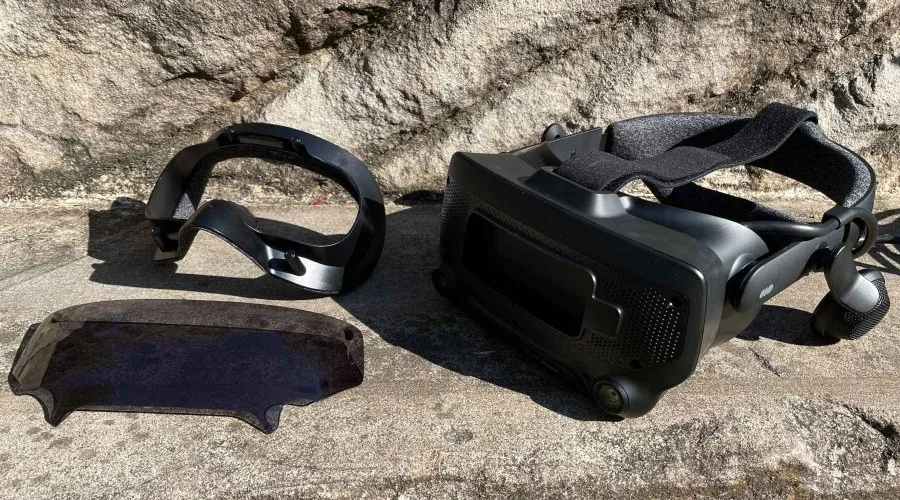
Image: Chris Stead/Finder
You don't need 20/20 eyesight to see that the design of the Valve Index headset sits very close to that of the HTC Vive Pro. However, I prefer the completely black, sleeker feel to the Valve Index. It's a sexy VR headset!
On its front are 2 forward-facing cameras for passthrough visuals of the world around you. There are detachable audio speakers which can be angled and moved down over your ears, and can also rotate out of the way. A 3.5mm audio jack allows you to do away with the headset's speakers altogether and use a better gaming headset instead. There's a built-in mic, too, for online communication. However, unlike the Vive Pro 2, the Valve Index doesn't feature on-cup audio controls – like volume – which is definitely a shame.
A head strap adjustment dial at the back allows you to get the device snug on your noggin, while a push button on one side of the front allows you to adjust the mask forward and back. The 58 to 70mm IPD (interpupillary) adjustment range is basically the same as the HTC Vive Pro 2.
Whereas the HTC Vive Pro 2 headset feels like one cohesive piece, the Valve Index is a little bit more compartmentalised. The foam cushioning in the mask clicks in and out easily, allowing you to take it out and clean it. The front visor also clips in and out easily, although I'm not sure why you'd do that. You can detach the connecting cable more easily, too.
While this flexibility is nice and works, the compromise is that the mask doesn't fit as snuggly against your face as the HTC Vive Pro 2. I noticed a bit of light bleed from the outside world creeping in around my nose, and it feels slightly more front weighted (less balanced) despite being the lighter product. That said, neither of these issues
bugged me while playing.
Like other tethered VR headsets, which is still essential if you want the very best visual experience, you need to deal with a dangling cord. To me it didn't feel quite as heavy on the Index as the Pro 2, but it's still annoying.
Valve Index controllers
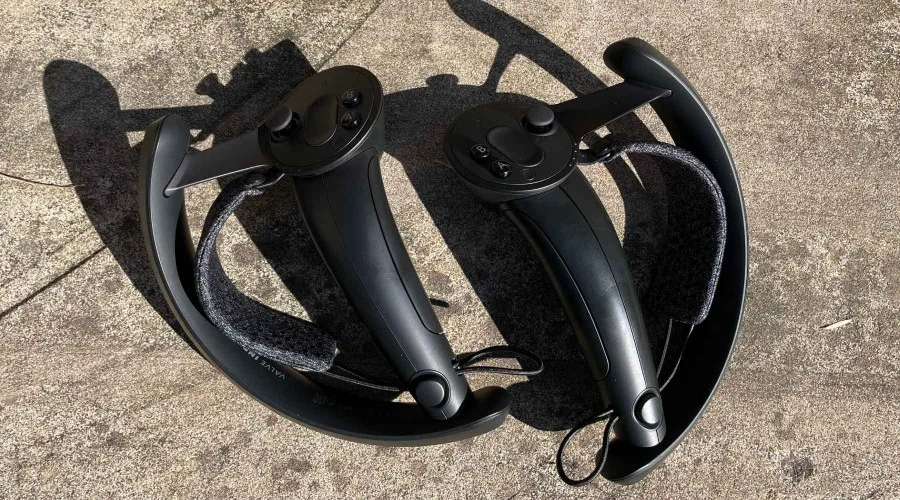
Image: Chris Stead/Finder
At the top of this review, I asked whether the Valve Index offered enough to stand out on its own given its similarities to the HTC Vive Pro 2. The answer comes in the controllers. Whereas the HTC Vive Pro 2 relies on the 2018-era wand controllers, the Valve Index opts for far superior tech.
The Valve Index controllers are great. They offer 6 degrees of freedom like their competitors, but the bigger feature is the finger and thumb tracking. So, each individual finger can be tracked as you move them up and down off the controller. While not all games support finger tracking, in those that do, the experience is mind-blowing. And you can always stick up a middle finger and at an enemy, which – trust me – you'll do.
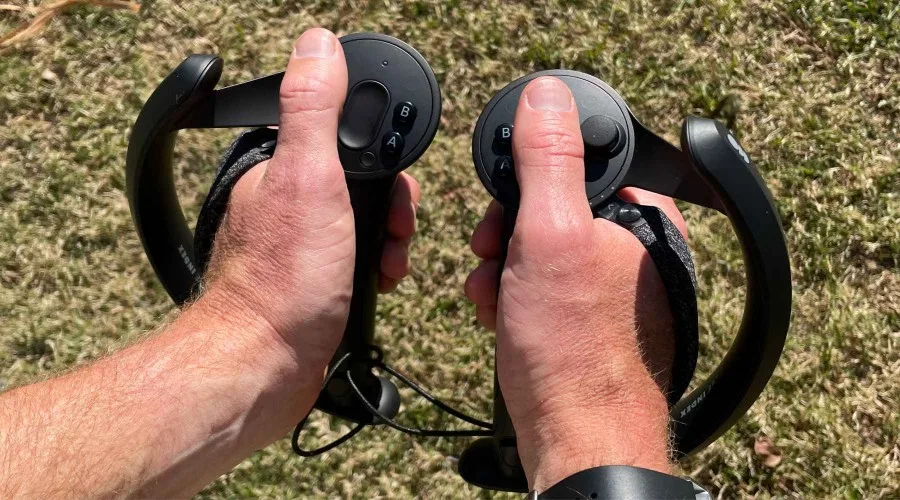
Image: Chris Stead/Finder
The design of the controller is also well thought out. They feel wonderfully ergonomic in your hands, with a padded strap you can tighten to ensure they will attach to your hands rather than needing to be gripped constantly. The plastic is smooth and pleasant to hold, and the thumb tracker, sticks, buttons and trigger are all perfectly placed. The Valve Index controllers even have 8-hour battery lives, a win over the Vive wand controller's 6 hours.
The only flaw is the small options/menu button. I really struggled to feel its location and to press it while I had the headset on. Although as it's not a button directly related to gameplay, this can be forgiven.
While I do love finger tracking, like many great pieces of tech in the past – Kinect comes to mind – it's not utilised in exciting ways often enough. A curated list of games with finger-tracking support on Steam is a good place to start your journey, but I feel there's a way to go yet until there is a diverse line-up of quality titles that make the most of finger tracking. Perhaps this will come if/when the HTC Vive Pro 2 updates its controllers.
Performance
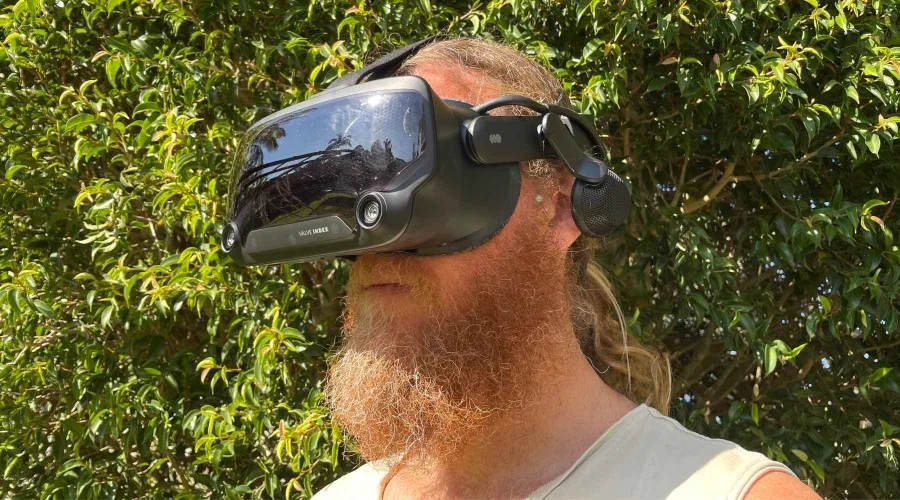
Image: Chris Stead/Finder
Perhaps what impressed me most about the Valve Index was that, despite its much lower resolution, the visual experience remains excellent. Testing the like-for-like experience of Half-Life: Alyx between the two headsets, the difference is minimal. The HTC Vive Pro 2 does look better and the wider view is more immersive. It's also a lot easier for ageing eyes like mine (I'm 42) to focus on that better resolution. But it's not the significant leap you might expect.
Indeed, the Valve Index even feels a bit crisper, in my opinion. The dreaded screen door effect is nowhere to be seen.
That said, I must admit to coming across more tracking bugs with the Valve Index than I did with the HTC Vive Pro 2. Frequently enough that it got annoying a controller would disappear from the game world or get stuck in a movement for a few heart beats. And sometimes it would recalibrate the game world's height oddly, placing me above or below the ground in ways not easily reset.
Research tells me there are third-party apps you can use to help counter these moments, but the reality is I didn't come across them often (if at all) during Vive Pro 2 sessions. Who is to blame here? The hardware perhaps, but the base stations are the same. Potentially then it's something to do with the controllers. But it could also be the games or the Steam VR operating system that's failing the Valve Index.
The reason is irrelevant to consumers, however. Is it a deal-breaker? No. I still had a lot of fun. I just had to spend more time mucking around in settings and room set-up than I would have preferred. But if you're weighing up the Pro 2 versus the Index, it's something to consider.
Audio and comfort
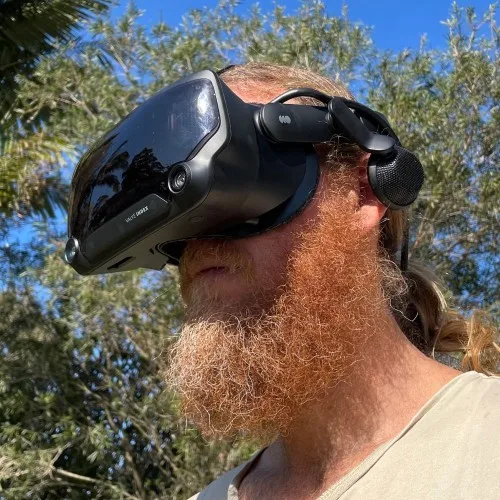
Image: Chris Stead/Finder
I also feel like the audio is a bit better on the Vive Pro 2 than the Index. Again, the software being used could play a role here, but when I tested like for like games, I found the sound on the Pro 2 to be a little fuller and louder. But overall, I'm still surprised by how well the sound comes out of this kind of speaker design, which doesn't offer the over-ear experience you get from dedicated gaming headsets.
The speakers do better than they look like they will, but I'd take a gaming headset over them every day of the week.
In terms of comfort, I did find that the Valve Index headset tended to fog easier than the Vive Pro 2 – similar in many ways to the fogging issues of the PlayStation VR headset. The airflow mustn't be as good. The Vive Pro 2 also has substantially more padding. However, it clasped onto my head well, and I didn't find myself constantly trying to rebalance it or push it back into place. Indeed, the headset never felt uncomfortable, even if it's not as plush as the Vive Pro 2.
For the sake of being totally transparent, my Valve Index base stations made a high-pitched mechanical sound while plugged in. I'm sensitive to such noises and it annoyed the hell out of me. However, given I did not have this problem using the same kind of base stations on the HTC Vive Pro 2, it could be isolated to my units.
Minimum computer system requirements
If you're new to the VR space, be warned that it's not just a good headset you'll need. You also require a high-end desktop or gaming laptop, although thankfully the requirements in recent years have become more palatable.
For the Valve Index, you'll need at least:
- Processor: Dual Core with Hyper-Threading
- Memory: 8GB RAM
- Graphics: Nvidia GeForce GTX 970 / AMD RX 480
- Ports: Available DisplayPort (Version1.2) and USB (2.0+) Port
However, a Quad Core CPU, Nvidia GeForce GTX 1070 (or better) and a spare USB 3.0 port is better. The HTC Vive Pro 2 has similar requirements, although requests a little bit more from your GPU.
Just note that if you have a gaming laptop, or even a PC, without a spare DisplayPort, you may face some dramas. You cannot use a DisplayPort to HDMi adaptor – I found that out the hard (read: expensive) way. However, you can use a DisplayPort to Thunderbolt Type-C converter. This is what I used to test out VR on my gaming laptop.
Should you buy the Valve Index?
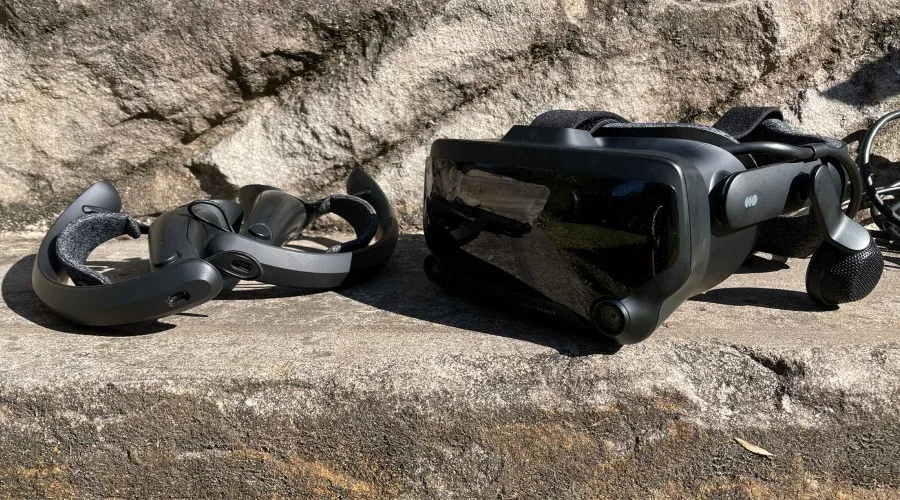
Image: Chris Stead/Finder
It's unclear if it talks more to the iterative nature of the HTC Vive Pro 2 than it does the forward-thinking of the Valve Index that the difference between the two VR headsets is minimal. In fact, in many ways the Valve Index is superior to the newer device. Its controllers are leagues ahead – not that there's a lot of software out there that makes fun use of it. And the visual clarity isn't the leap ahead you might suspect.
I did come across a few more bugs with the Valve Index tracking than I did with the HTV Vive Pro 2, as well as some hiccups in games. Although with the latter, it's hard to tell whether the blame here goes on the software or the hardware – or even on the Steam VR OS. There are a lot of moving parts.
The reality is that by having a range of different headsets all compatible with the Steam VR operating system, developers need to look at their games as being multiformat. They need to design them to work well across all headsets, rather than focusing on maximising the individual features of one unit. This creates a vanilla spread of games, which are capped by the lowest common denominator.
If you've got the money, the HTC Vive Pro 2 is going to offer you a better ecosystem, reliability and VR experience overall, especially if new controllers are released in the near future. But the Valve Index is well within touching distance. So, if you can find the Valve Index for $300 or $400 or so cheaper, it's certainly worth considering.
Valve Index price and availability
Even 2 years after launch, the Valve Index can be a little hard to come by in Australia. You can pick up the whole kit – headset, base stations and controllers – from EB Games for $1,899.95, although stock is coming and going quickly during COVID. This is almost 14% cheaper than the HTC Vive Pro 2 full kit. Alternatively, you can try and build the kit yourself from multiple sources – I've seen the headset available standalone on eBay for $1,299, for example.
But for many Australians, ordering direct from an overseas supplier may end up being the quickest and easiest way to get a Valve Index.
Specifications
Specs
Features
Images: Chris Stead
More Finder reviews
- Apple HomePod 2nd Gen review: Yes, it’s better
- Creality Ender-3 S1 Pro Review: Plenty of creative potential, but you’ll need patience too
- Apple Mac Mini M2 Pro review: A tale of two computers
- Apple MacBook Pro M2 Max 16-inch review: Next-level power
- HTC Vive XR Elite: Is this the perfect mix of Flow and Pro?
